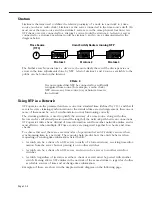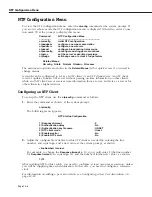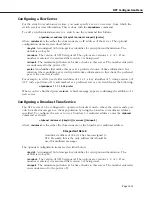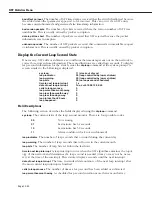
NTP Information Menu
Page 12-15
NTP Information Menu
To view the
NTP
configuration menu, enter the
ntinfo
command at the system prompt. If you
are using verbose mode, the
NTP
configuration menu is displayed. Otherwise, enter a ques-
tion mark (
?
) at the prompt to display this menu:
Command
NTP Information Menu
---------------
--------------------------------------------------------
ntplpeers
display list of peers the server knows about
ntppeers
display peer summary information
ntpdmpeers
display peer summary info the way Dave Mills likes it
ntpshowpeer
display detailed information for one or more peers
ntpvers
print version number
ntpinfo
display local server information
Related Menus:
Ntconfig Ntinfo Ntstats Ntadmin Ntaccess
The main menu options are shown in the
Related Menus
list for quick access if you need to
change menus.
Display List of Peers the Server Knows About
The
ntplpeers
command is used to display a brief list of all
NTP
associations related to this
switch (servers, peers, etc.).
To display a list of
NTP
associations, enter the
ntplpeers
command at the system prompt. A
display similar to the following is shown:
client 1.1.1.1
client 1.1.1.2
sym_active 1.1.1.3
The list shows the mode this switch is using in relation to the association, and the address of
the remote association. The address is either a domain name or an
IP
address. The available
modes are as follows:
Symmetric Active (1)
A host in this mode sends periodic messages regardless of the
reachability state of stratum of its peer. By operating in this
mode the host announces its willingness to synchronize and be
synchronized by the peer.
Symmetric Passive (2)
This type of association is ordinarily created upon the arrival of
a message from a peer operating in the symmetric active mode
and persists only as long as the peer is reachable and operat-
ing at a stratum level less than or equal to the host; otherwise
the association is dissolved. The association will always persist
until at least one message has been sent in reply. By operating
in this mode the host announces its willingness to synchronize
and be synchronized by the peer.
Client (3)
A host operating in this mode sends periodic messages regard-
less of the reachability state of stratum of its peer. By operating
in this mode the host, usually a
LAN
workstation, announces its
willingness to be synchronized, but not to synchronize the
peer.
Summary of Contents for Omni Switch/Router
Page 1: ...Part No 060166 10 Rev C March 2005 Omni Switch Router User Manual Release 4 5 www alcatel com ...
Page 4: ...page iv ...
Page 110: ...WAN Modules Page 3 40 ...
Page 156: ...UI Table Filtering Using Search and Filter Commands Page 4 46 ...
Page 164: ...Using ZMODEM Page 5 8 ...
Page 186: ...Displaying and Setting the Swap State Page 6 22 ...
Page 202: ...Creating a New File System Page 7 16 ...
Page 270: ...Displaying Secure Access Entries in the MPM Log Page 10 14 ...
Page 430: ...OmniChannel Page 15 16 ...
Page 496: ...Configuring Source Route to Transparent Bridging Page 17 48 ...
Page 542: ...Dissimilar LAN Switching Capabilities Page 18 46 ...
Page 646: ...Application Example DHCP Policies Page 20 30 ...
Page 660: ...GMAP Page 21 14 ...
Page 710: ...Viewing the Virtual Interface of Multicast VLANs Page 23 16 ...
Page 722: ...Application Example 5 Page 24 12 ...
Page 788: ...Viewing UDP Relay Statistics Page 26 24 ...
Page 872: ...The WAN Port Software Menu Page 28 46 ...
Page 960: ...Deleting a PPP Entity Page 30 22 ...
Page 978: ...Displaying Link Status Page 31 18 ...
Page 988: ...Displaying ISDN Configuration Entry Status Page 32 10 ...
Page 1024: ...Backup Services Commands Page 34 14 ...
Page 1062: ...Diagnostic Test Cable Schematics Page 36 24 ...
Page 1072: ...Configuring a Switch with an MPX Page A 10 ...
Page 1086: ...Page B 14 ...
Page 1100: ...Page I 14 Index ...
















































